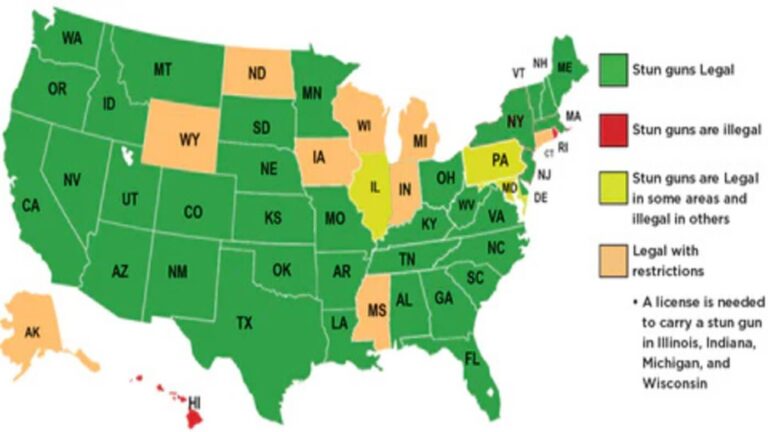Table of Contents
- Georgia Removes Permit Requirement for Stun Gun Ownership Expanding Legal Access
- Understanding the New Regulations and Compliance Responsibilities for Georgia Residents
- Potential Impact on Public Safety and Law Enforcement in Light of Stun Gun Legalization
- Best Practices for Responsible Stun Gun Use and Recommendations for New Owners
- Insights and Conclusions
Georgia Removes Permit Requirement for Stun Gun Ownership Expanding Legal Access
In a significant shift towards expanding self-defense rights, Georgia has officially eliminated the permit requirement for owning stun guns. This legislative change allows residents to purchase, carry, and use stun guns without undergoing the previous permit process, streamlining access to this form of non-lethal personal protection. Lawmakers emphasized that this move aligns with the state’s commitment to individual freedoms while still upholding public safety guidelines.
Key aspects of the new regulation include:
- Immediate legal possession: Individuals 18 and older can legally acquire stun guns without prior authorization.
- Unrestricted carry rights: Owners are permitted to carry stun guns concealed or openly in most public spaces.
- Safety measures remain intact: The state continues to prohibit stun gun possession in sensitive areas such as schools and government buildings.
Understanding the New Regulations and Compliance Responsibilities for Georgia Residents
Georgia’s latest legislative amendment now permits the possession of stun guns without the need for a traditional permit, marking a significant shift in the state’s approach to personal defense. This regulatory change removes previous bureaucratic barriers, allowing residents 18 years and older to legally carry these devices openly or concealed. However, while the permit requirement has been waived, individuals must still adhere to certain legal boundaries to maintain compliance and avoid potential penalties.
Key compliance responsibilities for Georgia residents include:
- Prohibition of stun gun possession by convicted felons or persons under certain restraining orders
- Restrictions on carrying stun guns in specified sensitive locations such as schools, government buildings, and federal properties
- Obligations to use stun guns solely for lawful self-defense purposes
- Awareness that misuse resulting in harm or assault may lead to criminal charges irrespective of ownership legality
Potential Impact on Public Safety and Law Enforcement in Light of Stun Gun Legalization
The recent legislation permitting stun gun ownership without a permit in Georgia is poised to reshape the landscape of public safety and law enforcement operations. While proponents argue that wider access to stun guns can empower civilians to better protect themselves against potential threats, law enforcement agencies are assessing the implications for on-the-ground policing. Officers might face increased challenges when distinguishing between lawful civilian usage and potential misuse, potentially complicating response protocols during confrontations.
Key considerations for public safety and law enforcement include:
- Potential rise in civilian availability of less-lethal weapons and how this affects crime deterrence and escalation.
- The need for updated training and guidelines for officers to effectively identify and engage situations involving stun guns.
- Balancing enhanced citizen self-defense rights with maintaining public order and minimizing accidental injuries.
- Ensuring clear communication and public education campaigns to prevent misunderstandings on the permissible use of stun devices.
Best Practices for Responsible Stun Gun Use and Recommendations for New Owners
New stun gun owners should prioritize safety and responsible use above all else. It is crucial to always treat a stun gun as a potentially lethal device, ensuring it is kept out of reach of children and unauthorized persons. Regularly inspect the device for damage or malfunction, and never rely solely on stun guns for personal protection; they should complement, not replace, situational awareness and common-sense precautions. Proper training on the correct deployment-aiming for the proper distance and target areas-minimizes the risk of accidental injury. Additionally, carrying a stun gun in compliance with local regulations remains essential despite the recent removal of permit requirements, as legal nuances may still apply in certain contexts.
For those just beginning to carry stun guns, consider these recommendations:
- Invest in professional training courses to understand operational techniques and safety protocols.
- Choose reliable, well-reviewed models that offer safety features such as trigger locks and battery indicators.
- Practice regularly with a dummy or training device to build familiarity without discharging the weapon.
- Maintain discretion by securely storing the stun gun and avoiding unnecessary display in public settings.
Insights and Conclusions
As Georgia moves forward with the new legislation legalizing stun gun ownership without a permit requirement, residents and law enforcement alike will be monitoring its impact on public safety and personal protection. This development marks a significant shift in the state’s approach to non-lethal self-defense tools, reflecting evolving attitudes toward individual rights and regulatory oversight. Stakeholders are encouraged to stay informed about the implementation process and any further legal updates as Georgia adapts to this change.Check Our Other Blogs
- StunGun – Your Trusted Source for Stun Guns, Laws, and Self-Defense Tips
- PepperSprayLaws – Your Trusted Resource for Pepper Spray Information
- StunGunLaws – Your Trusted Guide to Stun Gun Legality and Safety





